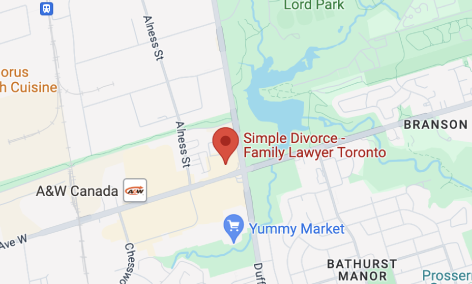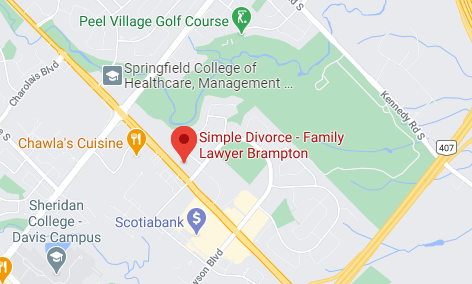Steps in a Contested Divorce in Ontario
With a simple divorce or joint divorce application, the parties in a divorce will generally go through a straightforward and fast process in terms of the conclusion of their divorce matter. However, where there are issues in dispute in a divorce (e.x. child custody, support, etc.), the divorce proceedings will have to go through the litigation process. This will result in various steps before the divorce proceedings are concluded.
In Ontario, the Family Law Rules set out the procedural rules applying to a divorce in Ontario. While it is common that settlement almost always happens before trial, there are various stages involved during a divorce in Ontario, which will require court appearances and meetings with judges and lawyers.
This article will provide a brief overview of the general steps involved with respect to litigating a divorce in Ontario.
(1) Reviewing Options
Prior to starting any formal divorce proceeding in Ontario you may want to consider other options for dealing with any issues that you and your spouse may have in dispute regarding your divorce in Ontario. Aside from going to court, there are alternatives such as mediation, collaborative law and even simply sitting down together and trying to come to an agreement regarding children, property and support matters. A good starting point prior to initiating any divorce proceedings is to contact a Toronto divorce lawyer to review your options.
If you and your spouse can co-operate from the beginning you will likely save a lot of time and money in legal fees and trips to the court for your divorce in Ontario. If the spouses agree on the issues their agreement will be finalized in a separation agreement. If executed properly with independent legal advice, the agreement will generally not be overridden by the courts and both parties will remain bound by its terms.
(2) Starting the Case: The Application
If, however, the spouses are unable to agree on issues relating to their divorce and separation, they will likely have to resolve their differences through the formal court process. To begin a court case one of the spouse will have to fill out an application for divorce which will state what they are seeking from their divorce. The spouse who brings the application is called the ‘applicant’. Issues such as child support, child custody, spousal support, property equalization, etc. will all be laid out in this application. It is a good idea to have a Toronto divorce lawyer prepare an application for divorce as it can be complicated. Once the application is prepared it must be filed with the court.
(3) Service
Once the application for divorce is filed with the court, the applicant will have to serve the other party (called the ‘respondent’) with the application. This step in divorce litigation is called service. Generally, service is done personally, which means that someone aside from the applicant will have to personally deliver the application to the respondent. One cannot just mail the application or slide it under the door. However, in circumstances where the respondent cannot be located or is trying to evade service, the court may grant permission to allow for a substituted method of service (e.g. registered mail) or may dispense with the service requirement altogether.
(4) Answer
Once the respondent is served with the application for divorce, the respondent will have 30 days to serve and file an answer within 30 days of being served (or 60 days if the respondent resides outside of Canada and USA). This deadline is a very important, as failure to comply can result in the case going ahead without the respondent – which could result in a court order being made in favour of the applicant. As is the case with preparing an application for divorce, it is probably in a respondent’s best interest to consult a Toronto divorce lawyer for assistance.
(5) Financial Statements
Financial statements are crucial documents where the parties are seeking a support order or order relating to the division of property. In the financial statement, the parties disclosure their finances including particulars regarding their income, expenses, debts and any assets they own.
According to the Family Law Rules of Ontario, where parties are making a claim for support or division of property they must file a financial statement. However, there are situations where the filing of a financial statement is not necessary, for example:
- if your claim is only for divorce,
- a spouse is only claiming child support pursuant to the table amount as set out in the Child Support Guidelines, or
- if both parties file a Motion to Change a support payment with consent and agree that filing a financial statement is unnecessary
(6) First Court Date
With cases that are being processed through the Ontario Court of Justice, a first court date will be set. However, with courts initiated through the Superior Court of Justice, only some cases will require a first court date. When the parties file their application the first court appearance will be found in the application. During the first court date a court clerk will usually make sure that the parties were properly served with the relevant document and that all relevant documents are filed with the court.
(7) Case Conference
In all contested family law cases, a minimum of one case conference must be held. Essentially, in a case conference the parties will speak to a judge about the various issues in dispute for their family law matter. Topics that are touched upon during a case conference include which issues the parties can and cannot settle, whether satisfactory disclosure of all relevant information has occurred, and the setting a date for the next stage of the case.
(8) Motions
A common step in a family case is what is referred to as a ‘motion’. Motions are used when the parties would like the court to make a temporary order on a matter. Both parties are free to request that a motion be heard. There are various reasons why a party may request a motion, for example asking for a temporary decision regarding child custody or for exclusive possession of the matrimonial home.
(9) Trial
If the parties are unable to resolve the issues in dispute, the final step will be a trial. The parties are free to represent themselves; however, it is generally advised to retain a family law lawyer to assist them during the trial. Trials are a last option. They can be quite drawn out and result in significant legal costs. In addition to the time and expense, a trial can be extremely stressful on a family.
For more information on steps in a contested divorce in Ontario or about obtaining a divorce in Ontario, please contact our Toronto divorce lawyer.
Helpful Resources:
Divorce and Separation
Family Justice Services
Child Custody and Access
Spousal Support
Child Support
Division or Equalization of Family Property
Treatment of a Matrimonial Home
Enforcement of Support Payments
Child Protection
Child Adoption



